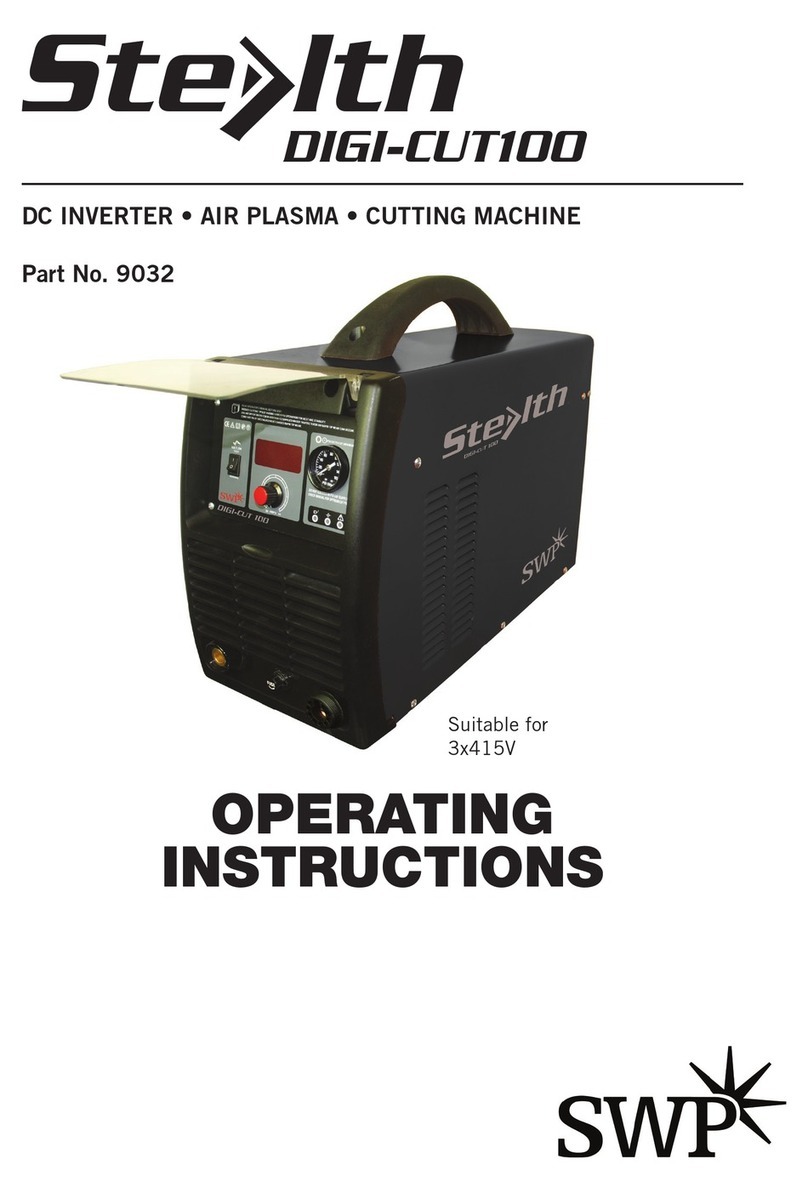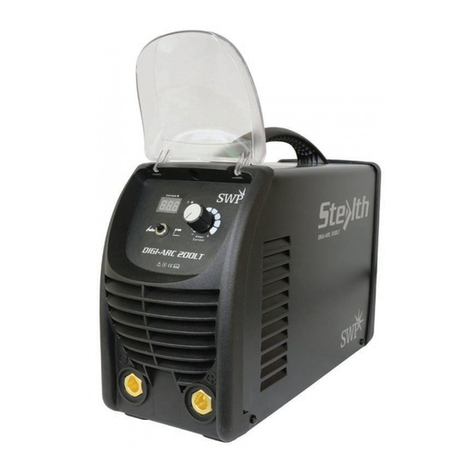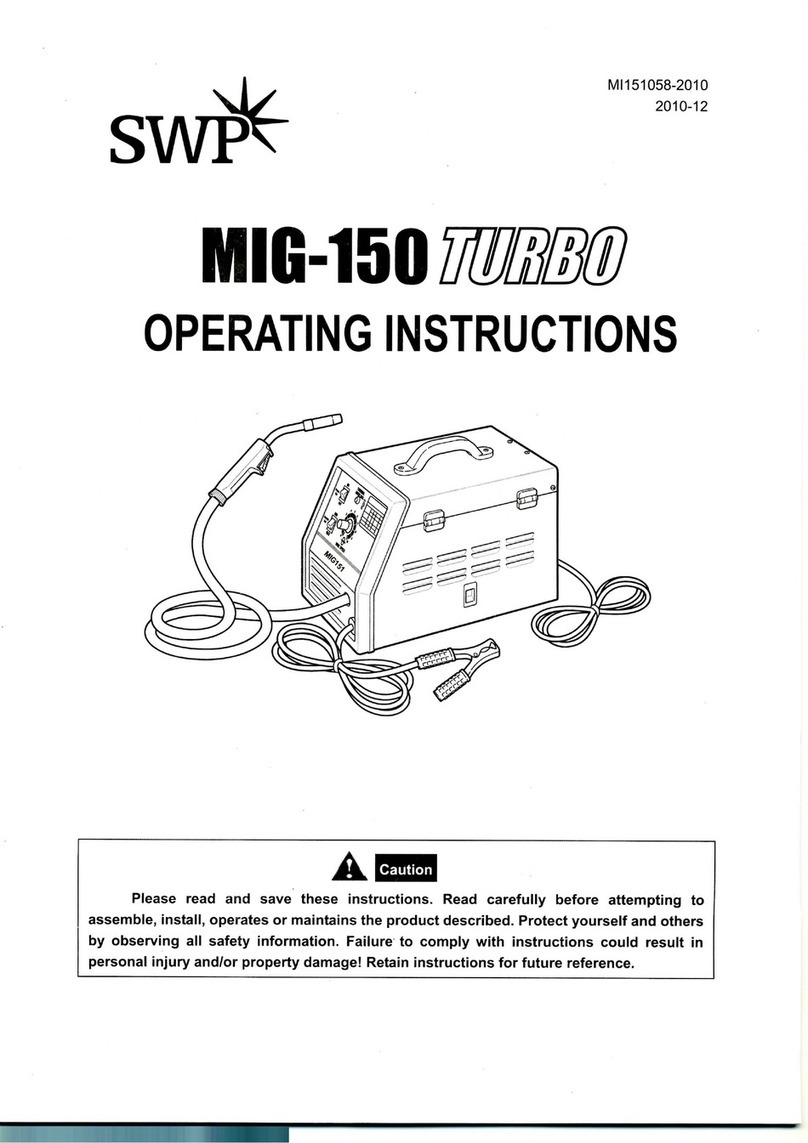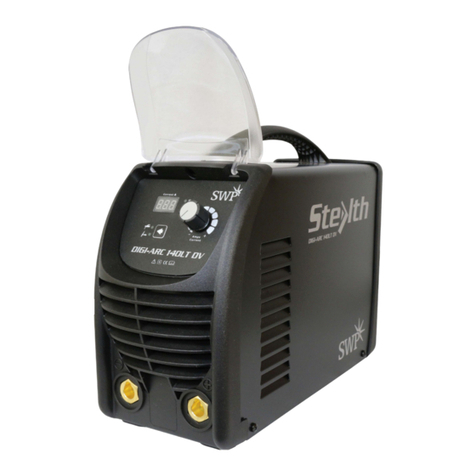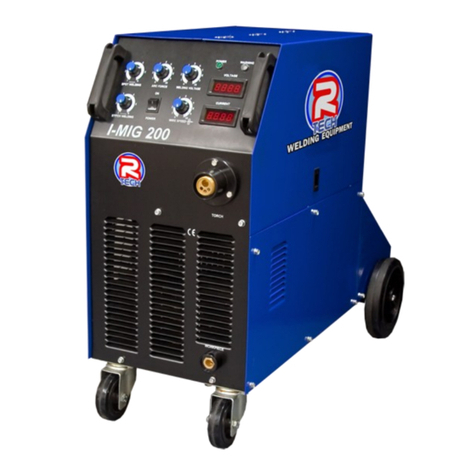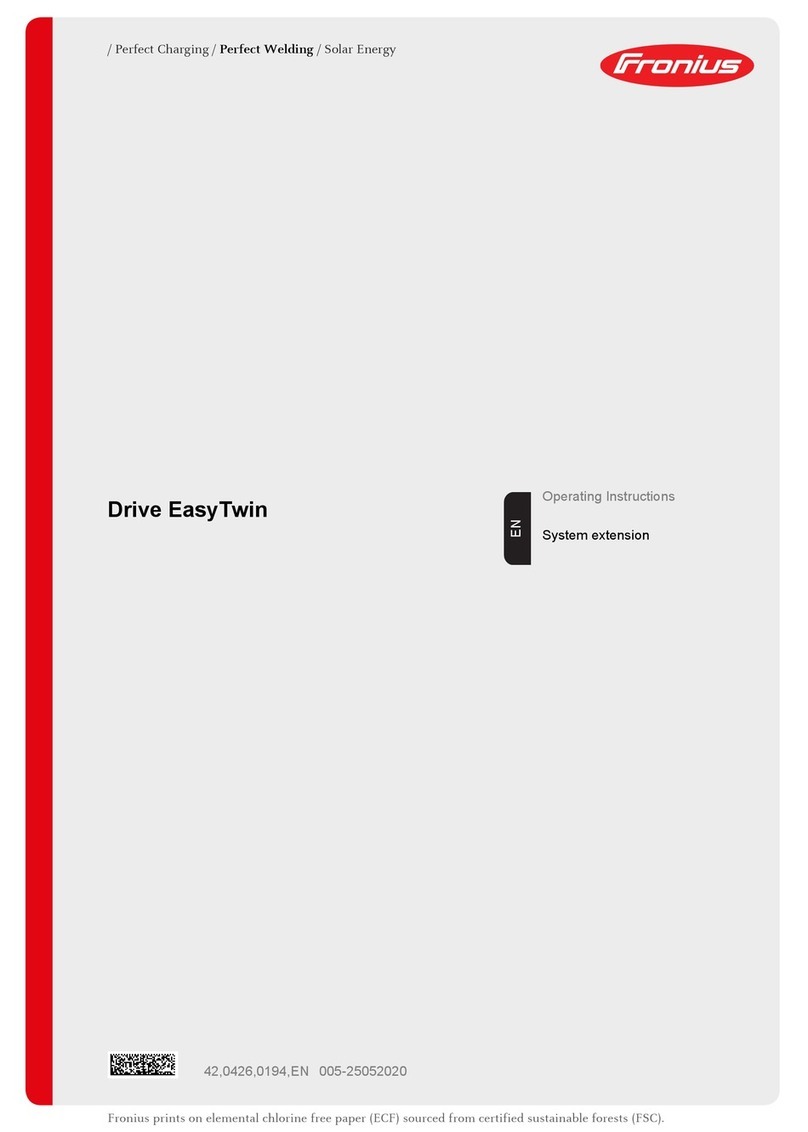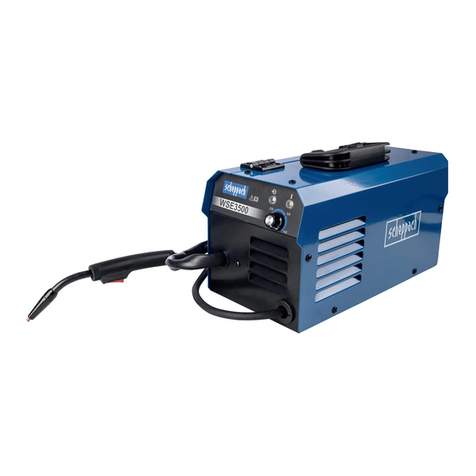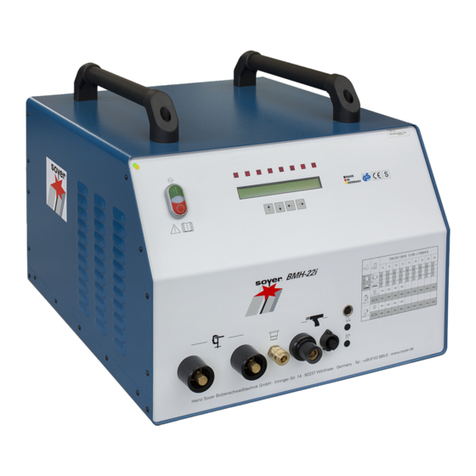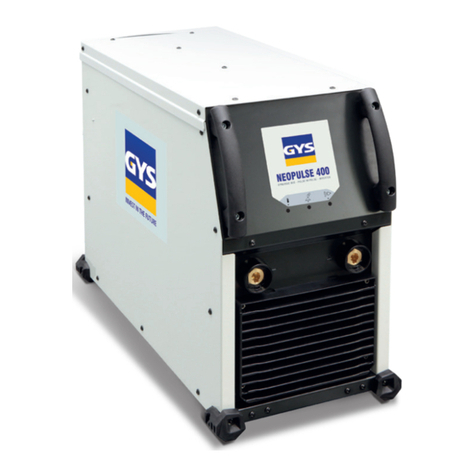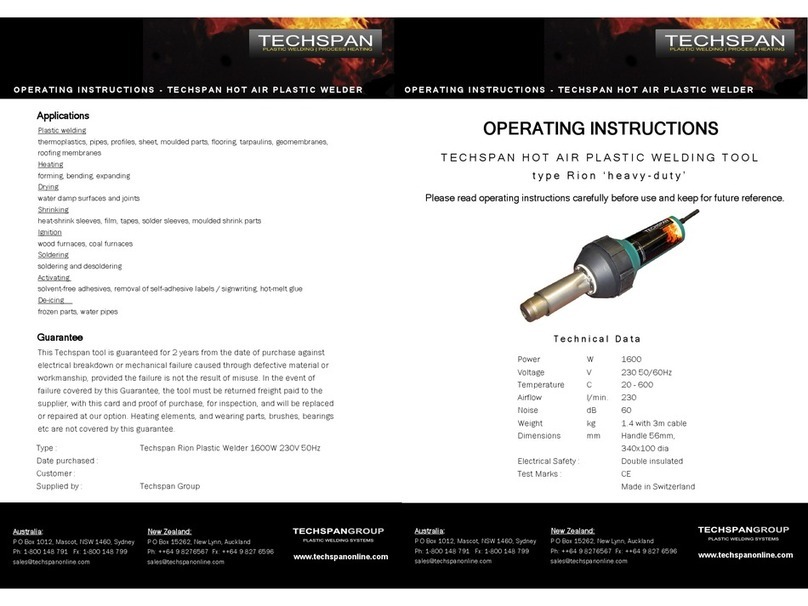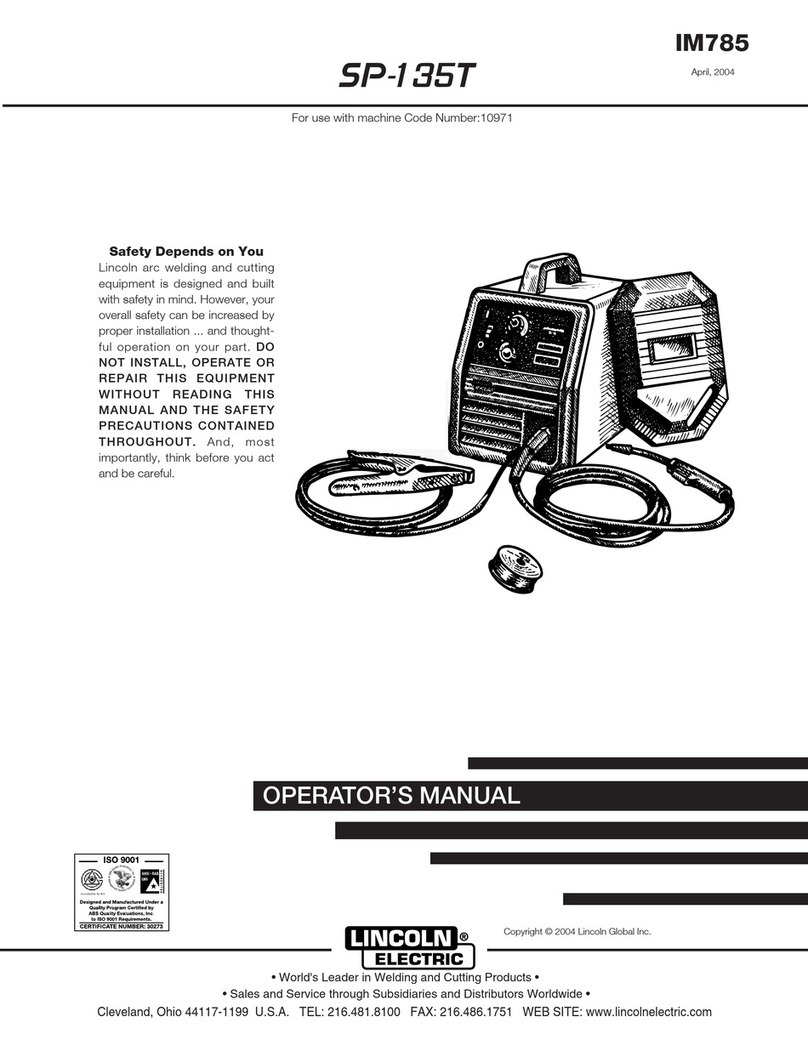SWP Stealth DIGI-CUT 40PFC MV User manual

Part No. 9030H
DIGI-CUT 40PFC MV
OPERATOR’S
MANUAL

STEALTH DIGI-CUT 40PFC MV
IMPORTANT
Read this Owner’s Manual completely before attempting to use this equipment.
Save this manual and keep it handy for quick reference. Pay particular attention
to the safety instructions provided for your protection. Contact your distributor if
you do not fully understand this manual.

CONTENTS
1 SAFETY 4
2 TECHNICAL INFORMATION 6
3 INSTALLATION AND ADJUSTMENT 7
3.1 UNPACKING 7
3.2 INPUT POWER CONNECTIONS 7
3.3 GAS CONNECTIONS 7
4 OPERATION CONTROL AND CONNECTORS 8
4.1 CUTTING PREPARATION 9
4.2 CUTTING OPERATION 9
5 CUTTING GUN MAINTENANCE 10
6 TROUBLESHOOTING 11
7 MAIN ELECTRICAL DIAGRAM 12
8 PARTS LIST 14
STEALTH DIGI-CUT 40PFC MV

OPERATION AND MAINTENANCE OF PLASMA ARC EQUIPMENT CAN BE
DANGEROUS AND HAZARDOUS TO YOUR HEALTH
Plasma arc cutting produces intense electric and magnetic emissions that may
interfere with the proper function of cardiac pacemakers, hearing aids, or other
electronic health equipment. Persons who work near plasma arc cutting applications
should consult their medical health professional and the manufacturer of the health
equipment to determine whether a hazard exists.
To prevent possible injury, read, understand and follow all warnings, safety precautions
and instructions before using the equipment.
GASES AND FUMES
Gases and fumes produced during the plasma cutting process can be dangerous and
hazardous to your health.
• Keep all fumes and gases from the breathing area. Keep your head out of the
cutting fume plume.
• Use an air-supplied respirator if ventilation is not adequate to remove all fumes and
gases.
• The types of fumes and gases from the plasma arc depend on the kind of metal
being used, metal coatings, and the different processes. You must be very careful
when cutting any metals which may contain one or more of the following:
Antimony Chromium Mercury Beryllium
Arsenic Cobalt Nickel Lead
Barium Copper Selenium Silver
Cadmium Manganese Vanadium
Always read the Material Safety Data Sheets (MSDS) that should be supplied with the
material you are using.
These MSDS will give you the information regarding the kind and amount of fumes and
gases that may be dangerous to your health.
• Use special equipment, such as water or down draft cutting tables, to capture fumes
and gases.
• Do not use the plasma torch in an area where combustible or explosive gases or
materials are located.
• Phosgene, a toxic gas, is generated from the vapours of chlorinated solvents and
cleansers. Remove all sources of these vapours.
ELECTRIC SHOCK
Electric Shock can injure or kill. The plasma arc process uses and produces high
voltage electrical energy.
This electric energy can cause severe or fatal shock to the operator or others in the
workplace.
• Never touch any parts that are electrically ‘live’ or ‘hot’.
• Wear dry gloves and clothing. Insulate yourself from the work piece or other parts of
the cutting circuit.
• Repair or replace all worn or damaged parts.
• Extra care must be taken when the workplace is moist or damp.
STEALTH DIGI-CUT 40PFC MV
1 SAFETY
4
§1 SAFETY
Important Safety Precautions
OPERATION AND MAINTENANCE OF PLASMA ARC EQUIPMENT CAN BE DANGEROUS AND
HAZ- ARDOUS TO YOUR HEALTH.
Plasma arc cutting produces intense electric and magnetic emissions that may interfere with the proper function
of cardiac pacemakers, hearing aids, or other electronic health equipment. Persons who work near plasma arc cutting
applications should consult their medical health professional and the manufacturer of the health equipment to deter-
mine whether a hazard exists.
To prevent possible injury, read, understand and follow all warnings, safety precautions and instructions before
using the equipment.
GASES AND FUMES
Gases and fumes produced during the plasma cutting process can be dangerous and hazardous to your health.
• Keep all fumes and gases from the breathing area. Keep your head out of the cutting fume plume.
• Use an air-supplied respirator if ventilation is not adequate to remove all fumes and gases.
• The kinds of fumes and gases from the plasma arc depend on the kind of metal being used, coatings on the
metal, and the different processes. You must be very careful when cutting or cutting any metals which may contain
one or more of the following:
Antimony
Chromium
Mercury
Beryllium
Arsenic
Cobalt
Nickel
Lead
Barium
Copper
Selenium
Silver
Cadmium
Manganese
Vanadium
Always read the Material Safety Data Sheets (MSDS) that should be supplied with the material you are using.
These MSDSs will give you the information regarding the kind and amount of fumes and gases that may be
dangerous to your health.
• Use special equipment, such as water or down draft cutting tables, to capture fumes and gases.
• Do not use the plasma torch in an area where combustible or explosive gases or materials are located.
• Phosgene, a toxic gas, is generated from the vapors of chlorinated solvents and cleansers. Remove all sources
of these vapors.
ELECTRIC SHOCK
Electric Shock can injure or kill. The plasma arc process uses and produces high voltage electrical energy.
This electric energy can cause severe or fatal shock to the operator or others in the workplace.
• Never touch any parts that are electrically “live” or “hot.”
1
§1 SAFETY
Important Safety Precautions
OPERATION AND MAINTENANCE OF PLASMA ARC EQUIPMENT CAN BE DANGEROUS AND
HAZ- ARDOUS TO YOUR HEALTH.
Plasma arc cutting produces intense electric and magnetic emissions that may interfere with the proper function
of cardiac pacemakers, hearing aids, or other electronic health equipment. Persons who work near plasma arc cutting
applications should consult their medical health professional and the manufacturer of the health equipment to deter-
mine whether a hazard exists.
To prevent possible injury, read, understand and follow all warnings, safety precautions and instructions before
using the equipment.
GASES AND FUMES
Gases and fumes produced during the plasma cutting process can be dangerous and hazardous to your health.
• Keep all fumes and gases from the breathing area. Keep your head out of the cutting fume plume.
• Use an air-supplied respirator if ventilation is not adequate to remove all fumes and gases.
• The kinds of fumes and gases from the plasma arc depend on the kind of metal being used, coatings on the
metal, and the different processes. You must be very careful when cutting or cutting any metals which may contain
one or more of the following:
Antimony
Chromium
Mercury
Beryllium
Arsenic
Cobalt
Nickel
Lead
Barium
Copper
Selenium
Silver
Cadmium
Manganese
Vanadium
Always read the Material Safety Data Sheets (MSDS) that should be supplied with the material you are using.
These MSDSs will give you the information regarding the kind and amount of fumes and gases that may be
dangerous to your health.
• Use special equipment, such as water or down draft cutting tables, to capture fumes and gases.
• Do not use the plasma torch in an area where combustible or explosive gases or materials are located.
• Phosgene, a toxic gas, is generated from the vapors of chlorinated solvents and cleansers. Remove all sources
of these vapors.
ELECTRIC SHOCK
Electric Shock can injure or kill. The plasma arc process uses and produces high voltage electrical energy.
This electric energy can cause severe or fatal shock to the operator or others in the workplace.
• Never touch any parts that are electrically “live” or “hot.”
1
§1 SAFETY
Important Safety Precautions
OPERATION AND MAINTENANCE OF PLASMA ARC EQUIPMENT CAN BE DANGEROUS AND
HAZ- ARDOUS TO YOUR HEALTH.
Plasma arc cutting produces intense electric and magnetic emissions that may interfere with the proper function
of cardiac pacemakers, hearing aids, or other electronic health equipment. Persons who work near plasma arc cutting
applications should consult their medical health professional and the manufacturer of the health equipment to deter-
mine whether a hazard exists.
To prevent possible injury, read, understand and follow all warnings, safety precautions and instructions before
using the equipment.
GASES AND FUMES
Gases and fumes produced during the plasma cutting process can be dangerous and hazardous to your health.
• Keep all fumes and gases from the breathing area. Keep your head out of the cutting fume plume.
• Use an air-supplied respirator if ventilation is not adequate to remove all fumes and gases.
• The kinds of fumes and gases from the plasma arc depend on the kind of metal being used, coatings on the
metal, and the different processes. You must be very careful when cutting or cutting any metals which may contain
one or more of the following:
Antimony
Chromium
Mercury
Beryllium
Arsenic
Cobalt
Nickel
Lead
Barium
Copper
Selenium
Silver
Cadmium
Manganese
Vanadium
Always read the Material Safety Data Sheets (MSDS) that should be supplied with the material you are using.
These MSDSs will give you the information regarding the kind and amount of fumes and gases that may be
dangerous to your health.
• Use special equipment, such as water or down draft cutting tables, to capture fumes and gases.
• Do not use the plasma torch in an area where combustible or explosive gases or materials are located.
• Phosgene, a toxic gas, is generated from the vapors of chlorinated solvents and cleansers. Remove all sources
of these vapors.
ELECTRIC SHOCK
Electric Shock can injure or kill. The plasma arc process uses and produces high voltage electrical energy.
This electric energy can cause severe or fatal shock to the operator or others in the workplace.
• Never touch any parts that are electrically “live” or “hot.”
1

STEALTH DIGI-CUT 40PFC MV
5
• Disconnect power source before performing any service or repairs.
• Read and follow all the instructions in the Operating Manual.
FIRE AND EXPLOSION
Fire and explosion can be caused by hot slag, sparks, or the plasma arc.
• Be sure there is no combustible or flammable material in the workplace. Any
material that cannot be removed must be protected.
• Ventilate all flammable or explosive vapours from the workplace.
• Do not cut or weld on containers that may have held combustibles.
• Provide a fire extinguisher when working in an area where fire hazards may exist.
• Hydrogen gas may be formed and trapped under aluminium workpieces when they
are cut underwater or while using a water table. DO NOT cut aluminum alloys under-
water or on a water table unless the hydrogen gas can be eliminated or dissipated.
Trapped hydrogen gas that is ignited will cause an explosion.
NOISE
Noise can cause permanent hearing loss. Plasma arc processes can cause noise levels
to exceed safe limits.
You must protect your ears from loud noise to prevent permanent loss of hearing.
• To protect your hearing from loud noise, wear protective ear plugs and/or ear muffs.
Protect others in the workplace.
• Noise levels should be measured to be sure the decibels (sound) do not exceed safe
levels.
PLASMA ARC RAYS
Plasma Arc Rays can injure your eyes and burn your skin. The plasma arc process
produces very bright ultra violet and infra red light. These arc rays will damage your
eyes and burn your skin if you are not properly protected.
• To protect your eyes, always wear a cutting helmet or shield. Also always wear safety
glasses with side shields, goggles or other protective eye wear.
• Wear cutting gloves and suitable clothing to protect your skin from the arc rays and
sparks.
• Keep helmet and safety glasses in good condition. Replace lenses when cracked,
chipped or dirty.
• Protect others in the work area from the arc rays. Use protective booths, screens or
shields.
2
• Wear dry gloves and clothing. Insulate yourself from the work piece or other parts of the cutting circuit.
• Repair or replace all worn or damaged parts.
• Extra care must be taken when the workplace is moist or damp.
• Disconnect power source before performing any service or repairs.
• Read and follow all the instructions in the Operating Manual.
FIRE AND EXPLOSION
Fire and explosion can be caused by hot slag, sparks, or the plasma arc.
• Be sure there is no combustible or flammable material in the workplace. Any material that cannot be removed
must be protected.
• Ventilate all flammable or explosive vapors from the workplace.
• Do not cut or weld on containers that may have held combustibles.
• Provide a fire watch when working in an area where fire hazards may exist.
• Hydrogen gas may be formed and trapped under aluminum workpieces when they are cut underwater or while
using a water table. DO NOT cut aluminum alloys underwater or on a water table unless the hydrogen gas can be
eliminated or dissipated. Trapped hydrogen gas that is ignited will cause an explosion.
NOISE
Noise can cause permanent hearing loss. Plasma arc processes can cause noise levels to exceed safe limits.
You must protect your ears from loud noise to prevent permanent loss of hearing.
• To protect your hearing from loud noise, wear protective ear plugs and/or ear muffs. Protect others in the
workplace.
• Noise levels should be measured to be sure the decibels (sound) do not exceed safe levels.
PLASMA ARC RAYS
Plasma Arc Rays can injure your eyes and burn your skin. The plasma arc process produces very bright ultra
violet and infra red light. These arc rays will damage your eyes and burn your skin if you are not properly protected.
• To protect your eyes, always wear a cutting helmet or shield. Also always wear safety glasses with side
shields, goggles or other protective eye wear.
• Wear cutting gloves and suitable clothing to protect your skin from the arc rays and sparks.
• Keep helmet and safety glasses in good condition. Replace lenses when cracked, chipped or dirty.
• Protect others in the work area from the arc rays. Use protective booths, screens or shields.
2
• Wear dry gloves and clothing. Insulate yourself from the work piece or other parts of the cutting circuit.
• Repair or replace all worn or damaged parts.
• Extra care must be taken when the workplace is moist or damp.
• Disconnect power source before performing any service or repairs.
• Read and follow all the instructions in the Operating Manual.
FIRE AND EXPLOSION
Fire and explosion can be caused by hot slag, sparks, or the plasma arc.
• Be sure there is no combustible or flammable material in the workplace. Any material that cannot be removed
must be protected.
• Ventilate all flammable or explosive vapors from the workplace.
• Do not cut or weld on containers that may have held combustibles.
• Provide a fire watch when working in an area where fire hazards may exist.
• Hydrogen gas may be formed and trapped under aluminum workpieces when they are cut underwater or while
using a water table. DO NOT cut aluminum alloys underwater or on a water table unless the hydrogen gas can be
eliminated or dissipated. Trapped hydrogen gas that is ignited will cause an explosion.
NOISE
Noise can cause permanent hearing loss. Plasma arc processes can cause noise levels to exceed safe limits.
You must protect your ears from loud noise to prevent permanent loss of hearing.
• To protect your hearing from loud noise, wear protective ear plugs and/or ear muffs. Protect others in the
workplace.
• Noise levels should be measured to be sure the decibels (sound) do not exceed safe levels.
PLASMA ARC RAYS
Plasma Arc Rays can injure your eyes and burn your skin. The plasma arc process produces very bright ultra
violet and infra red light. These arc rays will damage your eyes and burn your skin if you are not properly protected.
• To protect your eyes, always wear a cutting helmet or shield. Also always wear safety glasses with side
shields, goggles or other protective eye wear.
• Wear cutting gloves and suitable clothing to protect your skin from the arc rays and sparks.
• Keep helmet and safety glasses in good condition. Replace lenses when cracked, chipped or dirty.
• Protect others in the work area from the arc rays. Use protective booths, screens or shields.
2
• Wear dry gloves and clothing. Insulate yourself from the work piece or other parts of the cutting circuit.
• Repair or replace all worn or damaged parts.
• Extra care must be taken when the workplace is moist or damp.
• Disconnect power source before performing any service or repairs.
• Read and follow all the instructions in the Operating Manual.
FIRE AND EXPLOSION
Fire and explosion can be caused by hot slag, sparks, or the plasma arc.
• Be sure there is no combustible or flammable material in the workplace. Any material that cannot be removed
must be protected.
• Ventilate all flammable or explosive vapors from the workplace.
• Do not cut or weld on containers that may have held combustibles.
• Provide a fire watch when working in an area where fire hazards may exist.
• Hydrogen gas may be formed and trapped under aluminum workpieces when they are cut underwater or while
using a water table. DO NOT cut aluminum alloys underwater or on a water table unless the hydrogen gas can be
eliminated or dissipated. Trapped hydrogen gas that is ignited will cause an explosion.
NOISE
Noise can cause permanent hearing loss. Plasma arc processes can cause noise levels to exceed safe limits.
You must protect your ears from loud noise to prevent permanent loss of hearing.
• To protect your hearing from loud noise, wear protective ear plugs and/or ear muffs. Protect others in the
workplace.
• Noise levels should be measured to be sure the decibels (sound) do not exceed safe levels.
PLASMA ARC RAYS
Plasma Arc Rays can injure your eyes and burn your skin. The plasma arc process produces very bright ultra
violet and infra red light. These arc rays will damage your eyes and burn your skin if you are not properly protected.
• To protect your eyes, always wear a cutting helmet or shield. Also always wear safety glasses with side
shields, goggles or other protective eye wear.
• Wear cutting gloves and suitable clothing to protect your skin from the arc rays and sparks.
• Keep helmet and safety glasses in good condition. Replace lenses when cracked, chipped or dirty.
• Protect others in the work area from the arc rays. Use protective booths, screens or shields.

DIGI-CUT 40PFC MV
Power Supply Voltage (V) 90 VAC~275 VAC
Frequency (Hz) 50/60
1~110±10% 1~230±10%
Rated input current (A) 34.5 22.6
Rated input power (Kw) 3.8 4.9
Adjustment range of current (A) 20~30 20~40
Max no-load voltage (V) 320
35% 30A 50% 40A
Duty cycle (40ºC / 10 minutes) 60% 22A 60% 36A
100% 20A 100% 30A
Severance Cut for Carbon Steel (mm) ≤20 ≤25
Carbon Steel ≤15 ≤20
Optimal cutting Stainless Steel ≤15 ≤20
thickness (mm) Aluminium ≤12 ≤16
Copper ≤8 ≤12
Dimensions (mm) L x W x H 480 x 146 x 278
Protection class IP23
Insulation class H
Net weight (Kg) 7
Cooling method AF
STEALTH DIGI-CUT 40PFC MV
6
2 TECHNICAL INFORMATION

STEALTH DIGI-CUT 40PFC MV
7
3 INSTALLATION AND ADJUSTMENT
3.1 Unpacking
3.1.1 Use the packing lists to identify and account for each item.
3.1.2 Inspect each item for possible shipping damage. If damage is evident, contact
your distributor and / or shipping company before proceeding with the
installation.
3.2 Input Power Connections
Note: Check your power source for correct voltage before plugging in or connecting the
unit.
3.3 Gas Connections
3.3.1 Connecting Gas Supply to Unit
Connect the gas line to the inlet port of the gas filter on the rear panel.
3.3.1 Check Air Quality
To test the quality of air, put the RUN / SET switch in the SET (down) position.
Check if there is any oil or moisture in the air.

STEALTH DIGI-CUT 40PFC MV
8
4 OPERATION CONTROL AND CONNECTORS
1. Power Pilot Lamp: Turn on power – the lamp is lit.
2. Over-current, over-heat alarm: in the event the machine over-heats or over-current occurs,
the lamp is lit.
3. Cutting Gun Improper Installation and Air Pressure Low Alarm
(1) When short circuit unusually occurs between electrode and nozzle, the lamp is lit and
air feeds intermittently.
(2) When using a cutting gun with no electrode and nozzle installed, the lamp is lit and
air feeds intermittently .
(3) When the Shield Cup is not installed, the lamp flashes.
(4) When the air is low, the lamp is lit.
4. Voltage Pilot Lamp: turn on the cutting gun switch, generate voltage and the lamp is lit.
5. RUN/SET: When cutting the workpiece, turn to ‘RUN’; when performing a gas test, turn
to ‘SET’.
6. Compressed Air Connector.
7. Power Switch: Turn on or off the power source.
8. Power Cable: Connect to the appropriate power supply.
9. Cutting Current Regulator: Used to regulate the current when cutting.
10. Cutting Gun Connector.
11. Positive Output Cable: Connect to the workpiece.
5
§4 Operation
4.1 Layout Of The Front And Rear Panel
1. power pilot lamp: turn on power, the lamp on.
2. over-current ,over-heat alarm: when over-heat, over-current, the lamp would be on.
3. cutting gun improper installation and air pressure low alarm
(1)when short circuit occurred between the electrode and the nozzle for abnormal reasons, the lamp on , air feeds
intermittently.
(2)when cutting gun with no electrode and nozzle installed, the lamp on, air feeds intermittently .
(3)when the Shield Cup is not installed, the lamp flashes.
(4)when the air low, the lamp on
4. voltage pilot lamp: turn on the switch of the cutting gun, generate the voltage, the lamp on
5. RUN/SET: when cutting the workpiece, turn to the “RUN”; when doing gas test, turn to the “SET”.
6. compressed air connector
7. power switch: turn on or off the power source
8. power cable: connected to the appreciate power supply
9. cutting current regulator: it is used to regulate the current when cutting.
10. Cutting gun connector
11. positive output cable: connected to the workpiece
7
§4 Operation
4.1 Layout Of The Front And Rear Panel:
Fig 4.1 schematic drawing of the front panel and rear panel
1.Cutting current regulator: it is used to regulate the current when cutting.
2. Power pilot lamp
3. Over-current ,over-heat alarm :when over-heat, over-current, the lamp would be on.
4.Current display
5.Cutting gun improper installation and air pressure low alarm
6.Barometer display
7. Work lamp: turn on the switch of the cutting gun, generate the voltage, the lamp on
8. RUN/SET: when cutting the workpiece, turn to the “RUN”; when doing gas test, turn to the “SET”.
9.Cutting gun connector: connected to the cutting machine
10.remote control plug
11.Positive output cable: connected to the workpiece
12.Barometer :ensure there are no impurity and moisture in the compressed air
13.Power cable: connected to the appreciate power supply
14.Power switch: turn on or off the power source
12345
j
k
67
8
9

STEALTH DIGI-CUT 40PFC MV
9
4.1 Cutting Preparation
4.2.1 Tightly connect the power cable to an electrical socket outlet (refer to the Input
Voltage in section 2 Technology Parameters).
4.2.2 Connect the air pipe to the air supply equipment and the earth cable to the
workpiece.
4.2.3 Turn on the power switch, the power source lamp is lit.
4.2.4 Preparation is complete.
NOTE (1) The alarm lamp is on when cutting. Switch off the torch until the alarm
sounds, then press the switch again to restart cutting.
(2) During automatic gas test and examination, press on the cutting torch.
(3) After long use, the surface of the electrode and nozzle will have an oxidation
reaction. Replace the electrode and nozzle. The alarm lamp will light when
you remove the shield cup as a safety precaution.
4.2 Cutting Operation
6
4.2 Cutting Preparation
1、Tightly connect the power cable to electrical socket outlet (the input voltage, refer to the section 2 technology
parameters)
2、connect the air pipe to the air supply equipment, the earth cable to the workpiece
3、turn on the power switch ,the power source lamp on.
4、now all the preparation done .
4.3 Cutting Operation
Note:(1)The alarm lamp on when cutting, it is needed to loose the switch of the torch until the alarm release, then
press on the switch to start cutting again.
(2)In the automatic gas test and examine, press on the cutting torch, there will no reflection.
(3)After a long usage, the surface of the electrode and nozzle will have Oxidation reaction. Please replace the
electrode and nozzle, For The alarm lamp will on when install the shield cup, and stop working,
Turn on
the power
source
Loosethe
cutting
torch
switch
thetorch
leavesthe
workpiece,
thecutting
arcchange
intopilotarc
again
pressonthe
cutting
switch
Ignite the
pilotarc
Postgasfor
10s
shifttothe
workpiece,the
pilotarc
changeinto
cuttingarc
Arc
extinguished

STEALTH DIGI-CUT 40PFC MV
10
5 CUTTING GUN MAINTENANCE
WARNING 1. Check consumable parts for damage and replace if worn.
2. Turn off the power source before checking or removing cutting gun parts
NOTE When operating the torch in normal conditions, a small amount of gas vents
through the gap between the shield cup and the torch handle. Do not
attempt to over-tighten the shield cup as irreparable damage to internal
components may result.
7
§5 Maintenance
5.1 Cutting gun maintenance
Warning : 1. Check the consumable parts for damage, if worn, replace it.
2. Turn off the power source before check or remove cutting gun parts
Note: When operating the torch in a normal condition, a small amount of gas vents through the gap between the shield
cup and the torch handle, Do not attempt to over tighten the shield cup as irreparable damage to internal components
may result.

STEALTH DIGI-CUT 40PFC MV
6 TROUBLESHOOTING
WARNING There are extremely dangerous voltage and power levels present inside this unit.
Do not attempt to diagnose or repair unless you have had training in power
electronics measurement and troubleshooting techniques.
6.1 The cutting torch fails to ignite the arc when the torch is switched on and the TIP/
GUN/GAS light is on.
6.1.1 Gas pressure too high – gas test and adjust pressure to 4bar/60psi.
6.2 The cutting torch fails to ignite the arc when the torch is switched on and the TIP/
GUN/GAS lamp lights up.
6.2.1 Check shield cup installation. Turn off the power source and check the
electrode, cutting tip and shield cup are fitted correctly.
6.3 The cutting torch fails to ignite the arc when the torch is switched on with intermittent
air supply apparent.
6.3.1 The electrode or nozzle has been installed incorrectly – turn off the power
source, install the electrode or nozzle and screw shield cup down correctly, then
turn on the power source.
6.4 The cutting torch fails to ignite the arc when the torch is switched on and the TIP/GAS
light is on and air feeds intermittently.
6.4.1 Short-circuit for burned-out and other abnormal situations – turn off the power
source, change the electrode and nozzle.
6.5 Power lamp and temperature lamp is on.
6.5.1 Check for blocked air flow around the unit and it is in good working order.
6.5.2 Fan blocked – check and correct condition.
6.5.3 Unit is overheated – allow it to cool down for at least 5 minutes and make sure
the unit has not been operated beyond Duty Cycle limit. Refer to Technical
Information in Section 2.
6.5.4 Faulty components in unit – return to your distributor for repair or have a
qualified technician repair using the Service Manual.
6.6 Torch fails to ignite the arc when torch switch is activated.
6.6.1 System is in ‘SET’ mode – change to ‘RUN’ mode.
6.6.2 Faulty torch parts – inspect torch parts and replace if necessary.
6.6.3 Gas pressure is too high or too low – adjust to correct pressure.
6.6.4 Faulty components in unit – return to your distributor for repair or have a
qualified technician repair using the Service Manual.
11

STEALTH DIGI-CUT 40PFC MV
12
6.7 No cutting output. Torch is activated, power source is on, gas flows and fan operates
6.7.1 Torch not properly connected to power supply – check that torch leads are
properly connected to power supply.
6.7.2 Work cable not connected to work piece, or connection is poor – make sure
that work cable has a proper connection to a clean, dry area of the workpiece.
6.7.3 Faulty components in unit – return to your distributor for repair or have a
qualified technician repair using the Service Manual.
6.7.4 Faulty Torch – return to your distributor for repair or have a qualified
technician repair using the Service Manual.
6.8 Low cutting output
6.8.1 Incorrect setting of CURRENT control – check and adjust to correct setting.
6.8.2 Faulty components in unit. Return to your distributor for repair or have a
qualified technician repair using the Service Manual.
6.9 Difficulty Starting
6.9.1 Worn torch parts (consumables). Shut off input power. Remove and inspect
torch shield cup, tip and electrode. Replace electrode or tip if worn. Replace
shield cup if excessive spatter adheres to it.
6.10 Arc shuts off during operation. Arc will not restart when torch switch is activated.
6.10.1 Power Supply is overheated (OC/OT lamp is lit) – allow unit to cool down for
at least 5 minutes. Make sure the unit has not been operated beyond Duty
Cycle limit. Refer to Section 2 for duty cycle specifications.
6.10.2 Gas pressure too low (the TIP/GUN/GAS lamp is lit when torch is switched on)
– check source for at least 4bar/60psi and adjust as required (the machine
cover will require opening).
6.10.3 Torch consumables worn – check torch shield cup, tip, starter element and
electrode. Replace as required.
6.10.4 Faulty components in unit – return to your distributor for repair or have a
qualified technician repair using the Service Manual.
6.11 No gas flow, the power lamp is on and fan operates
6.11.1 Gas not connected or pressure too low – check gas connections. Adjust gas
pressure to correct setting.
6.11.2 Faulty components in unit – return to your distributor for repair or have a
qualified technician repair using the Service Manual.
6.12 Torch cuts but low quality
6.12.1 CURRENT control set too low – increase current setting.
6.12.2 Torch is being moved too fast across workpiece – reduce cutting speed.
6.12.3 Excessive oil or moisture in torch – hold torch 3 mm from clean surface while
purging and observe oil or moisture buildup (do not activate torch). If there are
contaminants in the gas additional filtering may be required.
5.3 Electrical principle drawing

13
STEALTH DIGI-CUT 40PFC MV
7 MAIN ELECTRICAL DIAGRAM
5.3 Electrical principle drawing

14
STEALTH DIGI-CUT 40PFC MV
8 PARTS LIST
9030H-02 COVER
9030H-03 FAN
9030H-05 AIR FILTER/REGULATOR
9030H-09 SOLENOID VALVE
9030H-15 FRONT PANEL
9030H-17 FEMALE TORCH CONNECTION
9030H-19 KNOB – USE 9000H-33
9030H-21 FRONT PCB
9030H-22 CONTROL PCB
9030H-24 RECTIFIER

15
STEALTH DIGI-CUT 40PFC MV

STEALTH DIGI-CUT 40PFC MV
Specialised Welding Products Ltd
Unit 1, Farringdon Industrial Centre, Farringdon, Nr Alton, Hampshire GU34 3DD, UK
This manual suits for next models
1
Table of contents
Other SWP Welding System manuals
Popular Welding System manuals by other brands
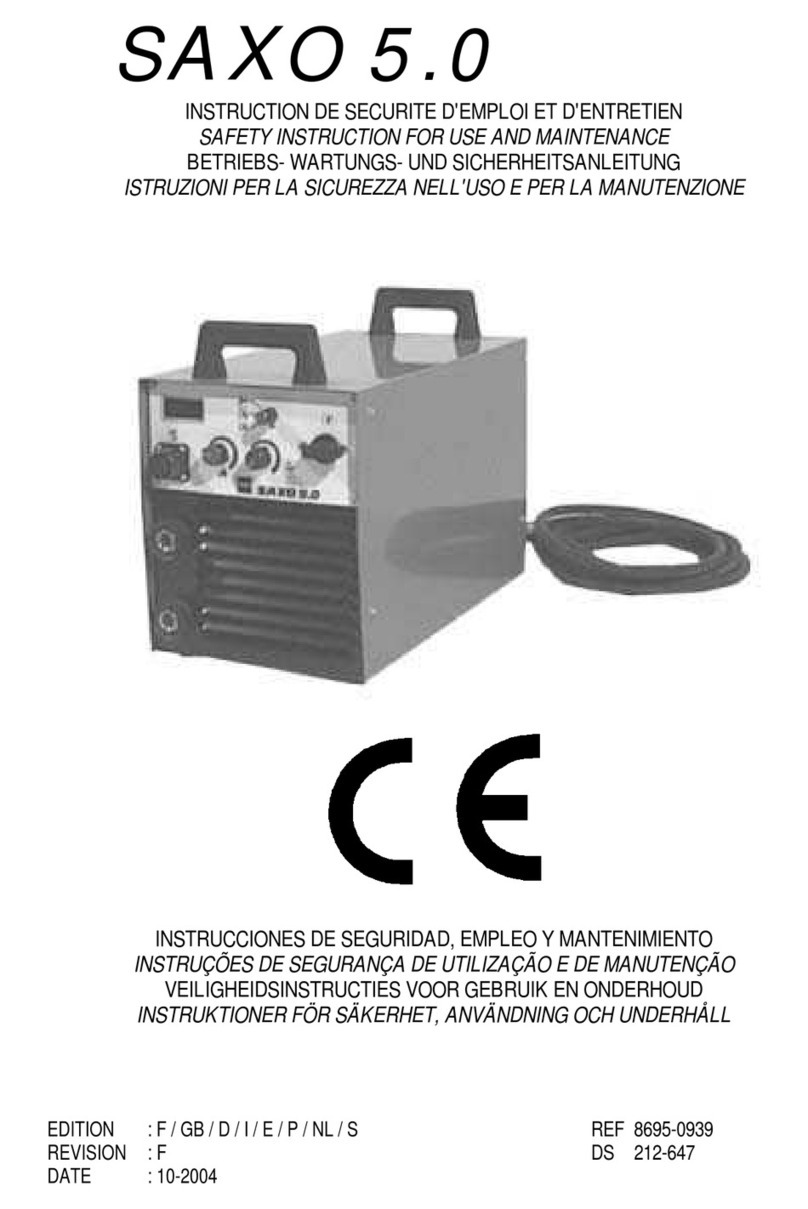
SAF
SAF SAXO 5.0 Safety instruction for use and maintenance
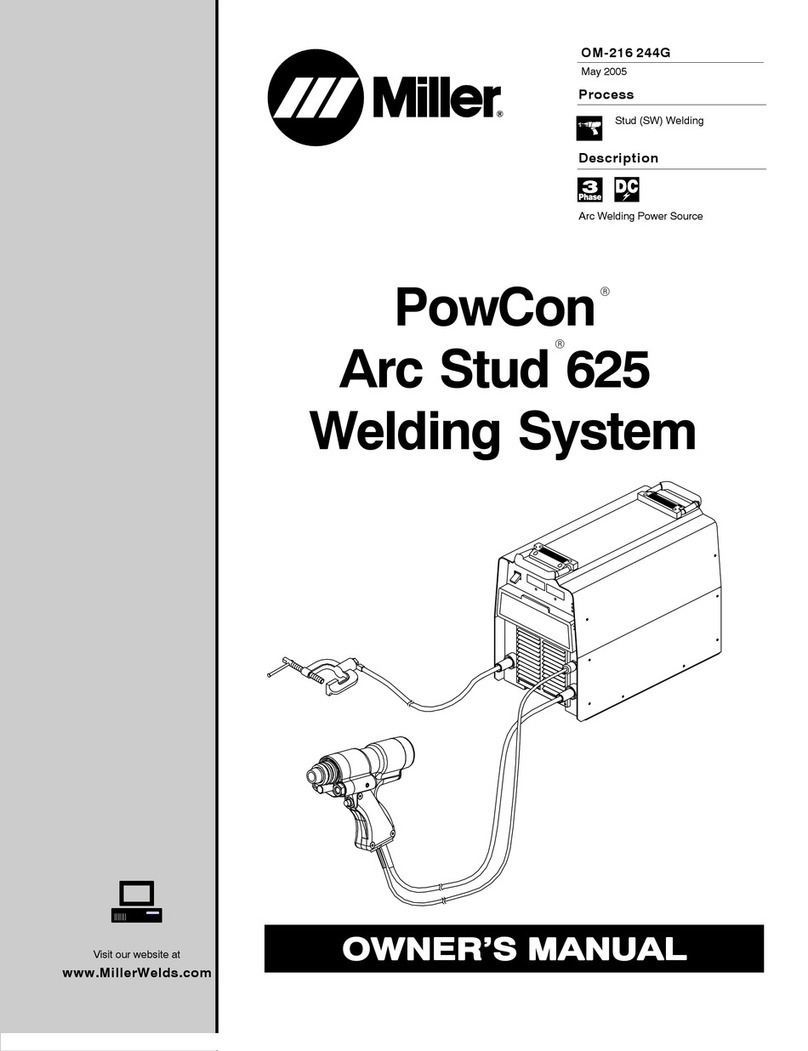
Miller
Miller PowCon Arc Stud 625 owner's manual
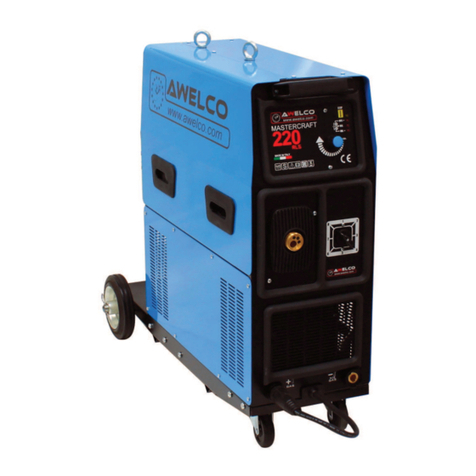
AWELCO
AWELCO MASTERCRAFT 220 user manual
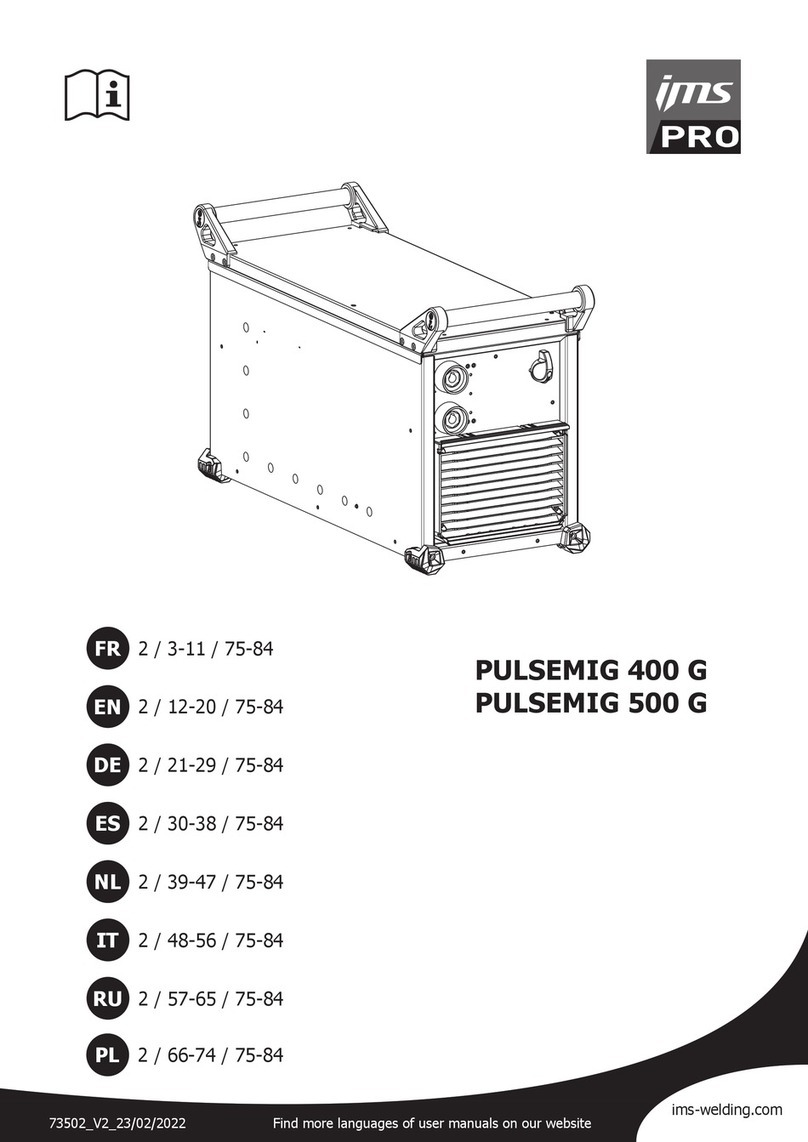
ims PRO
ims PRO PULSEMIG 400 G manual

Lincoln Electric
Lincoln Electric spirit II 150 Technical manual
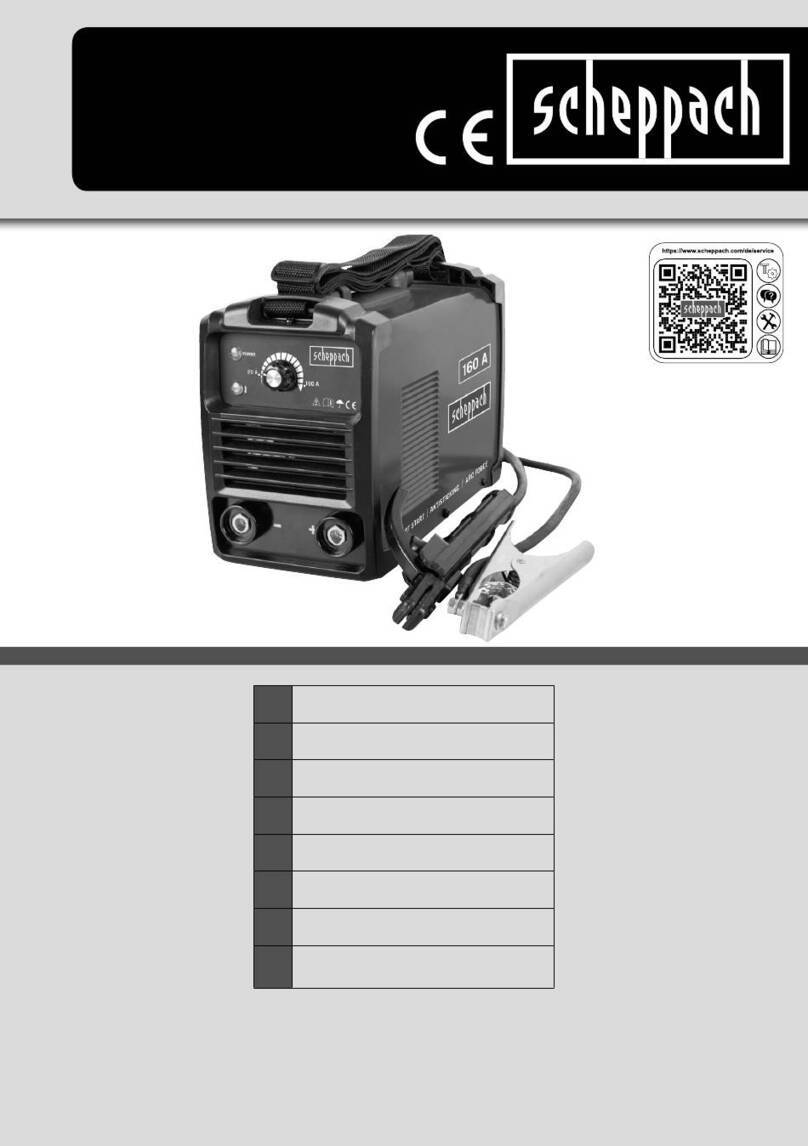
Scheppach
Scheppach WSE1100 Translation of original instruction manual
